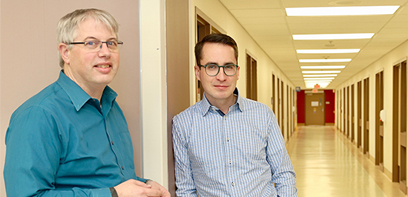Hair samples provide window into refugee stress
For the first time, researchers have been able to correlate a group’s self-reported feelings of stress and trauma with biological evidence of that stress. A study co-authored by Western researchers analyzed the concentration of cortisol – the so-called stress hormone – in the hair of refugees who had fled the Syrian war.
The cortisol was used as a biomarker to examine the associations between this hormone and self-reports of stress, insecurity, post-traumatic reactions and trauma among young people in Jordan who were enrolled in an eight-week program to learn stress awareness and skill acquisition.
Researchers partnered with Mercy Corps, a global humanitarian and development organization that works with adolescents on activities – which included vocational skills, technical skills, fitness or arts and crafts – intended to reduce the effects of profound stress. Mercy Corps believed the program was successful, based on participants’ responses, but wanted to be sure of its impact.
Researchers collected data from the youth before the program, at three months and 11 months after the program, and included data from hair samples they analyzed for cortisol levels.
They observed a decrease in cortisol concentrations by more than one-third – generally reflecting lower stress levels among participants. In some cases, cortisol was even raised in some youth whose levels were actually below normal.

Paul Mayne // Western NewsWestern Clinical Pharmacology and Endocrinology and Metabolism professor Stan Van Uum, left, along with Robarts Research Institute postdoctoral fellow Michael Greff, are part of a study that showed teens affected by the Syrian war indeed received biological benefits from an 8-week intervention program, lowering their cortisol levels – a hormone associated with stress.
The study is published in the Journal of Psychoneuroendocrinology and is co-authored by Western Clinical Pharmacology and Endocrinology and Metabolism professor Stan Van Uum, Robarts Research Institute postdoctoral fellow Michael Greff and professors at Yale, Harvard, Hashemite University (Jordan) and Queen Mary University (U.K.).
“I spend a lot of time in the lab doing all the cortisol analysis testing and it’s kind of nice to be able to see what I’m doing has a beneficial meaning to it,” said Greff. “We are able to give an objective measurement for humanitarian interventions. To be able to see it means something, that I’m not just running samples and getting numbers that maybe don’t mean anything, but that we’re able to justify when we go out to help people, what we’re doing is actually good.
“If you spend a couple weeks doing whatever it is through the intervention, you might think you feel better, but do you? They can say they feel better, but now we have data too,” Greff said.
Van Uum said the technique can offer a new window into the developmental impacts of past and current adversity and could be used to track the influence of interventions that target mental health and psychosocial wellbeing in humanitarian crises.
“It’s science not just for science, but science to make a difference,” said Van Uum.
High levels of cortisol can create issues such as suppressed immunity, hypertension, high blood pressure and cardiovascular disease. Hair samples are a good way to measure cortisol levels over time.
While studies of the biological stress response in war and disaster settings are largely based on observational or case-control studies, this study shows stress biomarkers such as cortisol can offer the potential to provide a biological signature of adverse experiences.
As of 2018, more than 5.3 million people have been forced to leave Syria – the largest refugee crisis since the end of the Second World War; more than 654,000 Syrians have taken refuge in Jordan, and half that number are children under 18.
Van Uum said the use of biomarkers for tracking changes in physiological stress can have beneficial consequences in protecting and improving adolescent health and development.
“If you are a humanitarian organization who wants to help, you wonder does it actually benefit or not, otherwise you put a lot of money into it and maybe feel better about doing something, but it doesn’t mean it improves anything,” he said. “Indeed, we see that effective interventions can improve not just self-reports of insecurity, stress, and mental health difficulties, but can also change and regulate young people’s physiology,” he said.
The study:
- Included 733 youth (411 Syrian war-affected refugees and 322 Jordanian non-refugees).
- Eight-week intervention program led by humanitarian group Mercy Corps, with sessions structured to teach teens stress awareness and skill acquisition. Youth reported less stress and better coping skills.
- Researchers collected data at three time points (before the program, at three months and 11 months after the program) and analyzed cortisol levels in participants’ hair samples.
- Cortisol concentration in hair samples reflected participants’ self-reported feelings of stress, trauma and improved wellbeing over time.
- This process can be used to track physiological effects of interventions to improve adolescent wellbeing, said researchers.
This article was written by Paul Mayne, and appeared in the January 18, 2018 edition of Western News.








